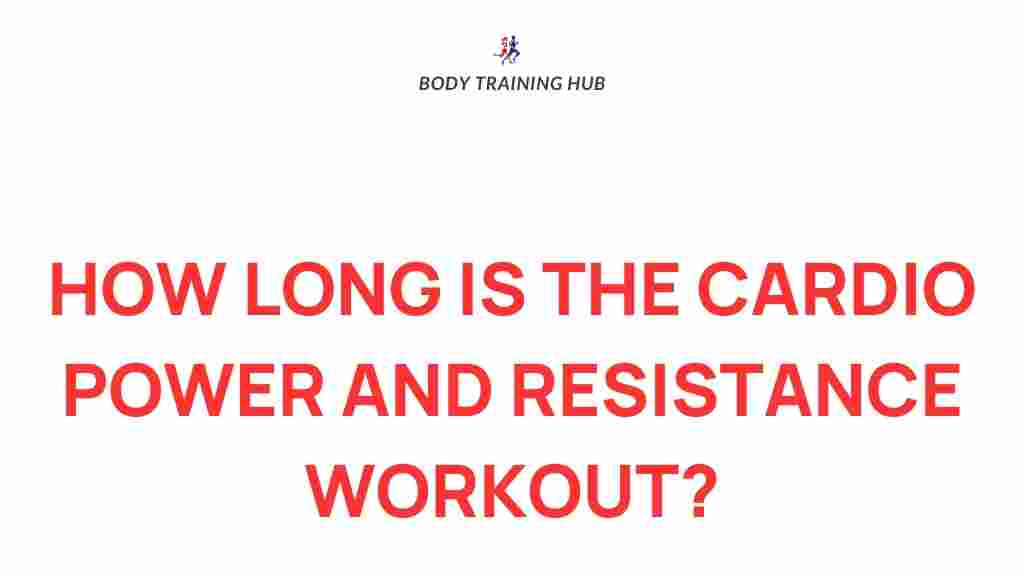Unveiling the Secrets of Cardio Power and Resistance
When it comes to enhancing your fitness level, understanding the balance between cardio, power, and resistance training is crucial. Each component plays a distinctive role in developing overall strength and endurance. In this article, we’ll explore the secrets behind these workout modalities and how they can be effectively combined for maximum results.
Understanding Cardio, Power, and Resistance
Before diving into specific workouts, let’s clarify what we mean by cardio, power, and resistance.
- Cardio: Short for cardiovascular exercise, this type of training focuses on elevating your heart rate to improve heart and lung function, enhancing overall stamina.
- Power: This refers to the ability to exert maximum force in short bursts, often involving explosive movements that combine speed and strength.
- Resistance: Resistance training involves lifting weights or using resistance bands to build muscle strength and endurance.
The Importance of Combining Cardio and Resistance Training
Integrating cardio with power and resistance can lead to improved performance in various physical activities. Here’s why:
- Enhanced Endurance: Cardio increases your aerobic capacity, allowing you to perform resistance exercises more effectively.
- Improved Power Output: Regularly incorporating power training can significantly enhance your strength, enabling you to lift heavier weights during resistance workouts.
- Fat Loss: Combining these training modalities can help burn fat more efficiently, leading to a leaner physique.
Designing Your Cardio and Resistance Workout
Creating a balanced workout routine that includes cardio, power, and resistance training requires careful planning. Here’s a step-by-step process to design an effective program:
Step 1: Assess Your Fitness Level
Before starting any new workout regime, it’s essential to assess your current fitness level. Consider the following:
- Current activity level—how often do you exercise?
- Any pre-existing health conditions or injuries.
- Your fitness goals—are you aiming to build muscle, lose weight, or improve cardiovascular health?
Step 2: Set Clear Goals
Your goals will dictate the structure of your workout. Are you looking to increase strength, build endurance, or enhance overall fitness? Setting SMART (Specific, Measurable, Achievable, Relevant, Time-bound) goals is recommended.
Step 3: Choose Your Cardio Exercises
Select cardio workouts that you enjoy and can sustain over time. Here are some effective options:
- Running or jogging
- Cycling
- Swimming
- High-Intensity Interval Training (HIIT)
Step 4: Incorporate Power Training
Include exercises that enhance your power output. These may include:
- Box jumps
- Kettlebell swings
- Medicine ball slams
- Olympic lifts (if trained)
Step 5: Design Your Resistance Training Plan
Resistance training should focus on all major muscle groups. Consider the following:
- Compound exercises (e.g., squats, deadlifts, bench presses)
- Isolation exercises (e.g., bicep curls, tricep extensions)
- Bodyweight exercises (e.g., push-ups, pull-ups)
Step 6: Create a Schedule
Plan a weekly schedule that balances your cardio, power, and resistance training. A sample week could look like this:
- Monday: Cardio (30 min running) + Resistance (upper body)
- Tuesday: Power (HIIT session)
- Wednesday: Rest or light cardio
- Thursday: Cardio (cycling) + Resistance (lower body)
- Friday: Power (explosive lifts)
- Saturday: Full body resistance training
- Sunday: Rest or active recovery
Troubleshooting Common Workout Challenges
As you embark on your training journey, you may encounter some challenges. Here are common issues and how to address them:
1. Lack of Motivation
Finding motivation can be tough. Try these tips:
- Set small, achievable goals.
- Workout with a friend or join a group.
- Track your progress to see improvements.
2. Plateaus in Progress
If you find that your progress has stalled, consider:
- Changing your workout routine every 4-6 weeks.
- Increasing weights in your resistance training.
- Adding new cardio exercises to your regimen.
3. Risk of Injury
Injuries can occur if you push too hard or use improper form. To minimize risk:
- Focus on proper technique, especially for power and resistance exercises.
- Incorporate warm-ups and cool-downs in your routine.
- Listen to your body—rest when needed.
Conclusion
Combining cardio, power, and resistance training is essential for achieving a well-rounded fitness level. By following the structured approach outlined in this article, you can effectively enhance your strength and endurance while enjoying your workouts. Remember, consistency is key, and adjustments to your routine will keep your training fresh and motivating.
For additional resources on workout routines and fitness tips, check out this helpful fitness guide. To explore more about the benefits of strength training, visit this article.
This article is in the category Cardio & Endurance and created by BodyTraining Team

2 thoughts on “Unveiling the Secrets of Cardio Power and Resistance”